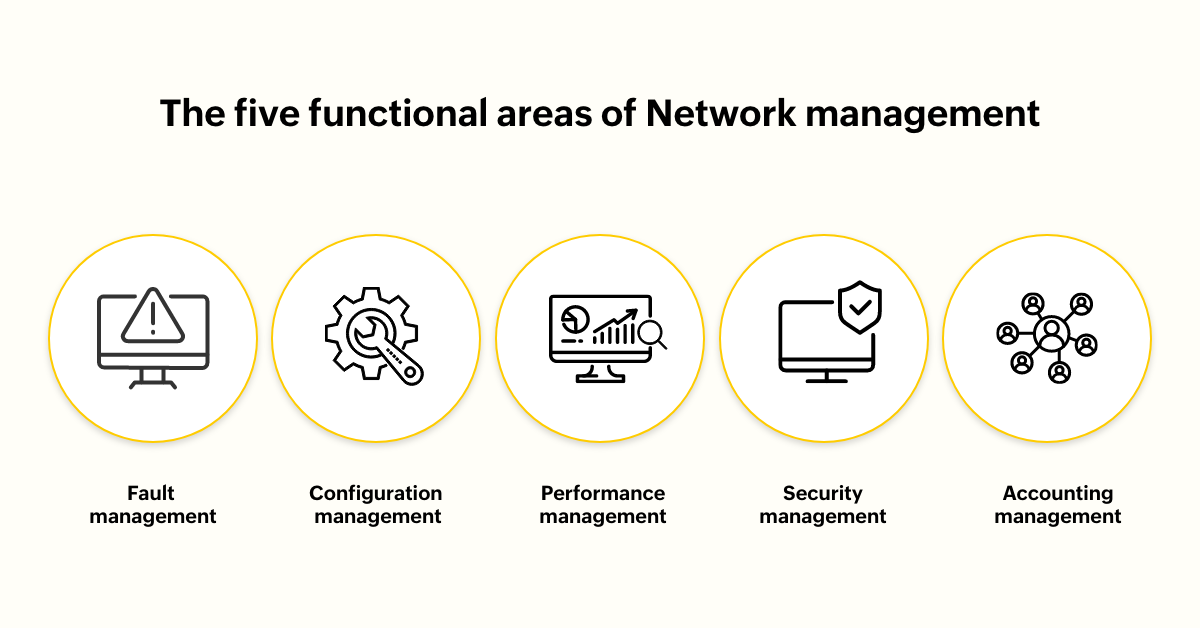Network management is the process of monitoring your network devices, interfaces, and virtual components, and orchestrating network traffic and data flow across the enterprise ecosystem. Using holistic network management software helps reduce manual intervention, improve performance, and maintain network connectivity. The main objective of enterprise network management is to ensure that network resources scaling across wired, wireless, and virtual infrastructure are readily available and easily accessible to users. A network management system encompasses a wide range of tools, functions, and applications that help keep your network integral, agile, and stable.
In the further read, we will discuss:
Network performance management functions as a crucial part of network monitoring due to its impeccable role in managing resources and enhancing security. The importance of network management process lies in its ability to ease the network admins' job by:
As per the International Standards Organization (ISO), the five functional areas of network management in computer networks are fault, configuration, accounting, performance, and security management (FCAPS). Network admins should incorporate each of these aspects into their network management strategy.

Network fault management is the process of detecting, isolating, and resolving network faults before they run into issues and impact end users. It also involves maintaining error logs, conducting fault analysis, and performing health audits. This helps the fault management team reduce MTTR and prevent future faults.
The dynamics in network configurations and their dependency on enterprise data and traffic requirements call for automation. Automation is the key to performing seamless configuration changes and updates. Configuration management also requires network admins to maintain a log of configuration details and changes to quickly identify issues.
The accounting management team keeps track of network resource usage for accounting and administration purposes. This type of management tracks utilization trends and finds anomalies pertaining to different business departments, functions, or sites. This also includes handling administrative duties such as validating user credentials and their access or permission levels.
The main objective of performance management is to monitor critical performance KPIs in real-time and ensure the smooth functioning of network operations. This entails performing threshold-based monitoring to get alerted on time to identify potential bottlenecks. The performance management team can also collaborate with the fault management team to correlate error data and initiate faster troubleshooting.
Security management protects the network from unauthorized access and potential security vulnerabilities. This system employs threat detection techniques such as authentication, encryption, and the implementation of firewalls to restrict user access, secure network resources, and prevent future attacks.
Network devices are highly interdependent. Disruption in one device may affect one or more devices, leading to sudden network downtime. To avert such situations, you can configure device dependencies so that when a seed router goes down, it's evident that all the dependent devices will go down. You can quickly fix your seed router to restore network uptime. This way, you can also eliminate a cascade of alerts and focus on the core issue.
Ensure high availability of your network monitoring system with failover options. This is essential for exerting disaster recovery in case the deployed network monitor goes down. The failover system will have all the data backed up and will automatically take over the dormant network monitor.
Understanding how the devices are connected to each other and across the network, how data flows within the ecosystem, and how the network devices interact with devices and services outside the network is paramount. Network maps help you achieve this. Keeping it updated helps you quickly locate devices and reduce MTTR in the event of downtime.
Have clear documentation of what's happening inside your network—the configurations you make, the resource levels you allocate, the usage patterns you notice, the compliance and security policies you devise, the warnings and messages that trigger, including event logs, error messages, and system logs. This helps you maintain a log of your entire network and easily backtrack to the root cause of an issue.
Keep track of network performance and store the data in the form of reports. With reports, you can understand the utilization trends and growth patterns of network devices and storage systems. Based on this, you can allocate or reallocate resources to critical devices and perform effective capacity planning. This way, you can make informed decisions on storage management and prevent indiscriminate purchases.
Automate superfluous tasks including restarting a server or service, starting/stopping processes, powering on/off VMs, and regular maintenance tasks including clearing cache, deleting old logs, upgrading hardware/software, and more. Effective netwo
Of all, the crucial aspect of network management is to choose a network management tool that does all and beyond the above-mentioned practices and makes the network admins' job easy. The network management tool you choose should support all the major vendors in the market and be able to integrate third-party ITSM tools to facilitate comprehensive network monitoring. It should help with all the key components of network management, such as network automation, network administration, network operations, network provisioning, network maintenance, and network analytics.
One such tool is ManageEngine OpManager. With extensive network monitoring and management capabilities, OpManager stands to be the most preferred network management solution by network admins. Download our 30-day, fully-functional free trial and level up your network monitoring game.